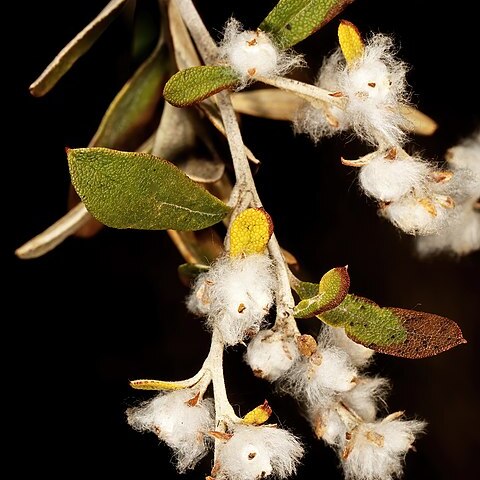Dioecious shrub or small, multi-stemmed tree, up to 8 m high. Leaves aromatic, alternate, oblanceolate or rarely obovate, (22-)25-60(-70) x 7-16 mm, discolorous, upper surface pale, dark green, hairy when young, becoming glabrous, glandular in reticulations, midrib sunken and hairy in lower part, lower surface densely whitish hairy, main and secondary veins prominent; apex obtuse to obtuse-mucronate, sometimes acute; base cuneate; margin often faintly denticulate in upper part, rarely entire. Petiole 1.5-5.0 mm long. Synflorescences terminal, paniculate. Male plants: capitula homogamous discoid, 5-9 mm diam., 10-30-flowered; peduncle 0-7 mm long. Involucral bracts fused halfway, 5-lobed; tube 1-2 mm long; lobes 1.0-1.5 mm long. Corolla infundibuliform, glandular and hairy; tube 1.5-2.0 mm long; lobes 5, 1.0-1.5 mm long, apex papillate. Anthers 5, exserted, 1.0-1.5 mm long, calcarate, caudate, tails 0.5 mm long, branched; filaments 2-3 mm long. Style well exserted, 4.0-5.5 mm long, entire or with 2 small lobes. Ovary rod-shaped, 0.5 mm long, sterile, septate-hairy. Female plants: capitula homogamous discoid, 3-4 mm diam., 1-3-flowered; peduncle mostly absent or up to 5 mm long. Involucral bracts free, 2-5 mm long, in 2 or 3 rows, narrowly lanceolate, narrowly ovate or elliptic, acute. Corolla infundibuliform, glandular and hairy; tube 0.5-1.0 mm long; lobes (4)5, 0.5-1.0 mm long, papillate. Style exserted, 1-2 mm long, lobes 2, 0.5 mm long. Ovary obovate to elliptic, 1.5-3.5 mm long, glandular and septate-hairy. Cypsela pale or dark brown, obovate, ribbed, 1.5-3.0 mm long, glandular and pure white, septate-hairy. Pappus absent. Flowering time: March to October with a peak from April to June (autumn to winter).
More
Shrub or tree, up to 8 m high. Leaves alternate, oblanceolate or rarely obovate, discolorous, upper surface pale, dark green, glabrous, lower surface densely whitish hairy, base cuneate, apex obtuse to obtuse-mucronate, sometimes acute, margins often faintly denticulate in upper part, rarely totally entire, shortly petiolate. Capitula discoid, terminal, paniculate, pedunculate; involucral bracts in a single row in male florets, fused halfway, in 2 or 3 rows in female florets, free. Florets male and female florets on different plants, dark, brownish. Flowering time Mar.-June. Pappus absent. Cypselae pale or dark brown, obovate, ribbed, densely long, white-hairy.


